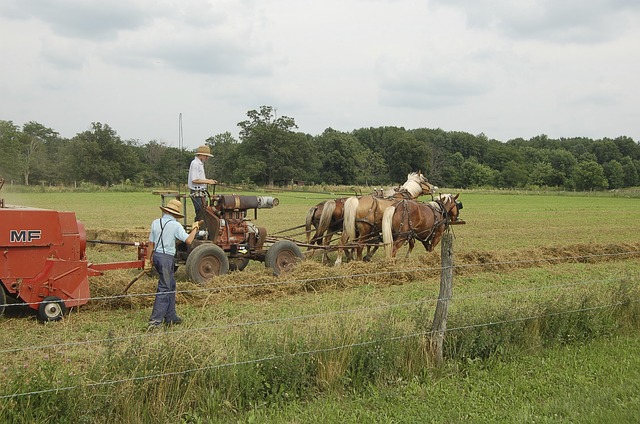The Amish are known for their old-fashioned, technology-free way of life, and researchers have found that they hold the answers on the origins of asthma.
Scientists studied the blood, genes and environmental dust of Amish kids from traditional farms in Indiana, and were able to determine that the innate immune system played a key role in stopping asthma, as well as the allergic reactions it can trigger, the Los Angeles Times reports.
Experts have long known that exposure to farm animals, and their microbes, can protect children from asthma. But the how and why of this remained a mystery, until now.
Amish children seemed to hold clues to this, as they appeared less susceptible to asthma compared to other kids.
The Centers for Disease Control and Prevention reports that 13.5% of US children have been diagnosed with asthma, and that 8.6% still have it. But only 5.2% of Amish children have asthma.
Researchers recruited 30 Amish children aged 7 to 14. They gave blood samples for immune system cell examination, and parents completed questionnaires on their child’s asthmatic symptoms. The researchers also collected dust from the living rooms and bedrooms of the Amish families involved.
After Indiana, the team moved to South Dakota, to the Hutterites. The Hutterites live in isolated farming communities that don’t use modern technologies such as televisions and computers. They descend from a group of Europeans who migrated to the United States in the 1800s in order to practice their Anabaptist faith freely.
The Amish and Hutterites have many practices in common that factor into asthma risks. Families are large, and mothers nurse their children for a prolonged period. Kids are not exposed to tobacco smoke or air pollution, and have no indoor pets. Vaccination rates are high, and while their diets contain plenty of fat and salt, there are few cases of obesity.
The one big difference between the two is that the Amish run their own small, family dairy farms and rely on horses for transportation and plowing. Hutterites, on the other hand, have large, communal farms that use modern farming equipment.
The researchers hoped that these groups would lead to the relationship between farm animals and asthma.
For each of the 30 Amish children, a Hutterite counterpart of the same age within a year, and gender, was recruited. The Hutterites also gave blood samples and the parents answered the same questionnaires. The researchers also collected dust from the homes.
The study found that six of the Hutterite children had asthma, which came to 20%. In contrast, none of the Amish children had asthma.
In line with this, the researchers discovered that the Amish blood samples had more neutrophils than the Hutterite samples. Neutrophils are immune system cells that are among the first to react when an infection enters the body. The Amish blood also had lower levels of eosinophils, a type of immune system cell that exacerbates inflammation that can lead to allergies.
Upon examining gene expression, the researchers found that genes that worked in innate immunity were more active in the Amish children than in the Hutterites.
The researchers likewise studied the dust they collected. They found that four of the 10 Amish samples and one of the 10 Hutterite samples had common allergens, including those from dust mites, cats, dogs and cockroaches. The levels of certain kinds of toxins were close to seven times higher in Amish dust than in Hutterites’.
Extracts of both kinds of house dust were administered to the noses of lab mice every two or three days for a month. As it turned out, the mix of organisms in the Amish dust protected the mice’s airways from having asthma-like responses when exposed to allergens. The Hutterite dust did not do the same.
The researchers repeated the experiments on another group of mice that did not have key genes needed in innate immunity. In this case, the asthma-blocking effect of the Amish dust was reduced greatly, proving that the innate immune system is behind the whole system of putting farm microbes to good use, according to the research.
Dr. Tala Chatila, a Harvard immunologist who wrote an accompanying editorial to the study, says that the study helped explain why farm life is linked to a reduced risk of asthma. But there are questions that still need to be answered, he says, such as whether kids have to keep getting exposed to farm animals to block asthma. Some protection might even happen during a mother’s pregnancy.
Carol Ober, researcher on the study and human genetics expert at the University of Chicago, admits that more work is necessary to translate these findings into treatments for asthma. “You can’t put a cow in every family’s house,” she says. “But we may be able to protect children from asthma by finding a way to re-create the time-tested Amish experience.”
The study was published in The New England Journal of Medicine.
























